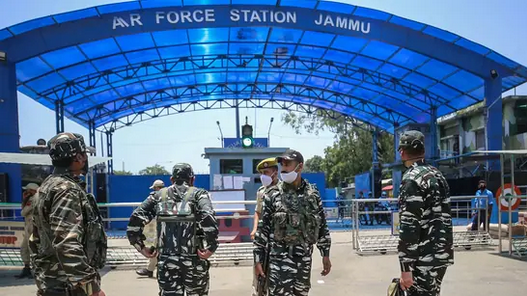
Jammu IAF base attack calls for robust counter-drone detection tech: Experts

Sunday’s drone attack on the Indian Air Force (IAF) base in Jammu is a wake-up call for the Indian government to step up infrastructure to counter rogue drones that pose serious security threats. Though the government finalised the National Counter Rogue Drone Guidelines in 2019 for handling the threats from Unmanned Aircraft System, it hasn’t been implemented yet.
The Federal spoke to Rajan Luthra, chair, Federation of Indian Chambers of Commerce & Industry Committee on Drones, and Ankit Mehta, CEO and co-founder of Ideaforge start-up to understand the existing counter-drone technologies, the cost involved and the challenges in deploying the same.
Also read: Crude bomb found after drone attack on IAF airport in Jammu
Based on the information available, the drone used in the Jammu attack appears to be a Small-Unmanned Aerial Vehicle (S-UAVs) operated from a shorter distance, which Luthra says would be difficult for the normal defence systems to track and it’s a challenge to tackle them.
“Globally, it’s a big challenge to counter the S-UAVs. They are of potential risk as they are easily available in the market and can be rigged to carry IEds and work in a shorter range,” he said.
Luthra says there are traditional methods like using Radars, and radio-frequency, through which one can detect and trace these S-UAVs. In the Radar method, the system detects the electromagnetic waves emitted from a transmitter to determine the size and speed of the UAV and employ algorithms to distinguish between drones and other small, low-flying objects, such as birds.
Luthra also pointed at the FICCI report on countering rogue drones prepared in 2019 which said Radio frequencies can be used to track such drones or using visual cameras and through acoustic systems that can pin down the drones based on the noise of UAV rotors.
While detection and tracing of rogue UAVs is just one part of the complex problem, neutralizing the threat through hacking or by spoofing the GPS or through jammers to disrupt the radio frequency link between the drone and its operator is also important.
“There has to be an integrated system. Typically with radiofrequency, radars or jamming technology, the range is limited to 3-5 km. So large scale deployment of such a system is not financially viable,” Luthra said. “India is not far behind in deployment of these technologies. The cost would be upward of a few crore rupees (₹1-3 crore),” he says.
FICCI estimates the total market potential of counter UAVs to be worth ₹49,000 crore.
Mehta, who is also part of the FICCI committee says there is no ‘silver bullet’ in anti-drone solution. “None of the solutions (whether Indian or from western nations) will give 100 per cent detection (ESM) and destruction (ECM) assurance. And the technology is still new and this particular technology hasn’t matured fully,” Mehta said.
“So the need is to do a nuanced threat assessment of an asset and deploy these Anti-Drone Systems and with time, better technology and ecosystem will develop,” Mehta said.
Since 2019, as part of the committee’s objective, the team has worked with the Ministry of Defence, Bureau of Police Research and Development and paramilitary forces, to make the agencies aware of the challenges of rogue drones.
The Defence Research and Development Organisation has last year come up with a counter-drone technology that could detect and jam micro-drones at a distance of up to 3 km and lase a target 1-1.25 km far depending on the wattage of the laser weapon.
Chief of Defence Staff (CDS) General Bipin Rawat on Monday said India has to start preparing for the future generation of warfare. In an interview to CNN-News18, he said the Army, Navy and Air Force are working in a joint and integrated manner and that the latter should become the lead agency in evolving countermeasures to tackle rogue drones in the future.
“Today, most of these technologies are imported and we need indigenous ones. Though DRDO made progress, there’s still a need for technology transfer from companies that deploy them around the world so that it can be customised to India’s needs,” Luthra said.
Also read: Day after attack, alert security forces foil another drone attack in Jammu
He cautioned the government that a counter-reaction to this attack should not have a negative impact on the industry, disrupting the thriving ecosystem. “Drones are a transformative technology. There is no point in preventing the use of drones,” he said. They are helping in land surveys, agriculture operations, and post-pandemic for delivery of medicines and vaccines in certain states (on a trial basis).
“It’s just a matter of time where counter-drone mechanisms are brought in through proper risk assessment. The government should let professionals design proper systems and later develop indigenously,” Luthra said.

